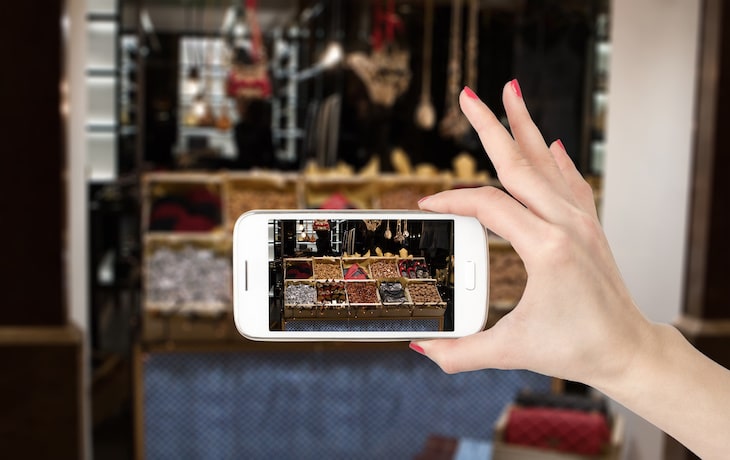Believe it or not, online and old school physical stores CAN (and often should) exist together. The secret lies with integrated marketing and just how deep a retailer is willing to go syncing the online and offline worlds.
Global ecommerce sales grew by 18% in 2018, according to Digital Commerce 360. This increased online’s total share of retail sales to just over 15%.
But take note of the flipside of that. 85% of sales still occurred offline, most of that in traditional brick-and-mortar stores. So while online continues to grow, the vast majority of purchases still happen on a counter next to a cash register.
Facebook’s 2019 Holiday Shopping guide for Facebook marketers notes that consumers still want to see products in person, and they get many emotional benefits from the in-store experience that are hard to reproduce online.
Zero Sum Game?
Bottom line: brick-and-mortar retail is far from dead. But as ecomm continues a slow-but-steady growth, a myth persists that it is the enemy of in-store. Online is seen as inevitably cannibalizing in-store sales.
No doubt in some specific verticals it has done just that. Made a trip to Blockbuster any time recently?
In reality, many traditional stores are thriving. Marketplace lists some that are doing particularly well in 2019, and some of the names might surprise you. Among them are Best Buy, Costco, and Five Below.
Here’s the secret, though: ecommerce and brick-and-mortar are not engaged in a zero sum game. At least, they don’t have to be. In fact, they are at their best when the two work together in an integrated marketing vision.
Integrated marketing rejects choosing one marketing channel, strategy, or platform to the exclusion of all others. Instead it seeks to build a cooperative synergy among all for the ultimate goal of sustainable profitability.
Brick-and-Mortar and Ecommerce Integrated Marketing

What does the integration of ecommerce and brick-and-mortar store (Ecomm/BaM) marketing look like?
Seamless User Experience
At the heart of successful Ecomm/BaM integrated marketing is a unified customer experience across the board.
As accessibility to goods and services increased in the Industrial Age, so did competition. This led to a shift to an increasingly consumer-driven economy. Consumers figured out they were in control, and learned to use that power to demand a superior in-store experience. This led to a whole science and industry emphasizing store design, customer service, and convenience.
Consumers expect the same online, just substituting site design for store design. In fact, those factors may be even more critical online than in-store, as there is very little friction keeping an online shopper from going somewhere else if their experience is negative.
More importantly from an integration standpoint, consumers will inevitably impute their experience online to the BaM store, whether that is fair or not. It doesn’t matter if your real world store has top notch customer service if the consumer is mistreated by your online store. That consumer is unlikely to set foot in your BaM store, where the ultimate sale might have been made.
Shop Here; Buy There
The last sentence in the previous section brings up another reality of today’s retail world: many people will shop in one mode and purchase in another.
Many people will use your online store to research what you have available, get an idea of your prices, or find out basic information such as your store locations and policies. If all of that goes well, they may then make a purchase the next time they are in one of your stores.
But it can work the other way as well. Some probably prefer the in-store browsing experience but may not be ready to buy at that time. If they know you have an online store, and they feel confident that their experience there will be as good as in your store, they may eventually complete their purchase online.
The key to success here is providing a seamless, quality, similar experience from online to in-store and back again.
Pro Tip: make sure you aren’t fencing your customers into a “one and done experience.” Sure, if they’ve visited your web site you’d love for them to convert there. But you have to make it as easy as possible for those who aren’t going to do that to find and exercise the option to buy where they want to.
Make sure your site lets visitors know you have BaM locations near them, and give easy access to information about those stores. Also let them know they have options. For example, putting “These prices available online and at all stores!” on a sale page.
Similarly, you should promote your store’s site in your BAM outlets and in print ads and circulars.
Integrate Your Campaign Creative
As advocated by Marty Weintraub in 17 Integrated Marketing NEW Best Practices to Test, the creative you use across all marketing channels (not only online but also in print, billboards, in-store displays, etc.) should be intentionally sequenced to lead the prospect through their journey, even if that journey will be from online exposure to in-store purchase (or vice versa).
You do this by targeting high-intention keywords, designing specific (but campaign-integrated) creative for each, and using those in special remarketing campaigns.
Integrate Psychographic Data
Psychographics mashes information about consumers’ attitudes, behaviors, desires, values, and interests with demographic information to produce more in-depth personas for targeted marketing and remarketing.
The magic of psychographics over traditional persona building is its ability to uncover previously-hidden areas of intent.
Now what would happen if you integrated in-store and online psychographic data? Deep magic, that’s what! Consumers can reveal themselves in slightly different ways in each of those worlds. If you can develop means of joining their online and offline data, you end up with richer intentional targeting for all your campaigns.
How will you integrate brick-and-mortar with ecommerce in your marketing campaigns?









